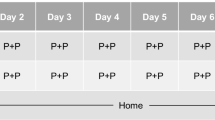Summary
A double blind cross-over study was performed to compare the sensitivity of “oof road” driving with that of laboratory tests of driving-related skills to drug induced sedation. Twelve experienced drivers (6 M, 6 F) received single oral doses of the H1-antagonist diphenhydramine 25, 50 and 100 mg and placebo. Each treatment was administered on 2 separate occasions, once in the driving school when real driving skills were assessed and again in the laboratory when performance of an adaptive tracking task, body sway and visual reaction were measured. On all occasions subjects assessed their own performance and alertness/sedation using visual analogue scales. Data were subjected to analysis of variance and differences assessed by Newman Keul's test. Diphenhydramine failed to impair driving performance at any dose while all doses produced significant changes in each of the 3 laboratory tests. Subjects rated themselves sedated after all 3 doses of active drug in the laboratory but only after the 100 mg dose in the driving school. Tests performed in the psychopharmacology laboratory appear to be more sensitive to the sedative effects of diphenhydramine than tests of “off road” driving. The implications are discussed.
Similar content being viewed by others
References
Skegg DCG, Richards SM, Doll R (1979) Minor tranquillisers and road accidents. Br Med J 1: 917
Honkanen R, Ertama L, Linnoila M, Alha A, Lukkari I, Karlsson M, Kiviluoto O, Puro M (1980) Role of drugs in traffic accidents. Br Med J 281: 1309–1312
Jick H, Hunter JR, Dinan BJ, Madsen S, Stergachis A (1981) Sedating drugs and automobile accidents leading to hospitalization. Am J Public Health 71 [12]: 1399–1400
Biehl B (1979) Studies of clobazam and car-driving. Br J Clin Pharmacol 7: 85S–90S
O'Hanlon JF, Haak TW, Blaauw GJ, Riemersma JBJ (1982) Diazepam impairs lateral position control in highway driving. Science 217: 79–81
Hindmarch I, Gudgeon AC (1980) The effects of clobazam and lorazepam on aspects of psychomotor performance and car handling ability. Br J Clin Pharmacol 10: 145–150
Cohen AF, Burke C, Peck AW, Fowle ASE, McPhail A, Buckley C (1983) Effects of alcohol, amitriptyline and bupropion on skills related to car driving. Br J Clin Pharmacol 15: 613P-614P
Milner G, Landauer AA (1971) Alcohol, thioridazine and chlorpromazine effects on skills related to driving behaviour. Br J Psychiatry 118: 351–352
Fink M, Irwin P (1979) CNS effects of the antihistamines diphenhydramine and terfenadine (RMI 9918). Pharmacopsychiatrie 12: 35–44
Carruthers GS, Shoeman DW, Hignite CE, Azarnoff DL (1978) Correlation between plasma diphenhydramine level and sedative and antihistamine effects. Clin Pharmacol Ther 23: 375–382
Moser L, Huther KJ, Koch-Weser J, Lundt PV (1978) Effects of terfenadine and diphenhydramine alone or in combination with diazepam or alcohol on psychomotor performance and subjective feelings. Eur J Clin Pharmacol 14: 417–423
Borland RG, Nicholson AW (1974) Human performance after a barbiturate (heptabarbitone). Br J Clin Pharmacol 1: 209–215
Scott DB, Fagan D, Tiplady B (1982) Effects of amitriptyline and zimelidine in combination with ethanol. Psychopharmacology 76: 209–211
Hamilton M, Burke C, Strutt A, Peck AW (1983) A brief portable reaction time test and automated visual analogue scales: sensitivity to antihistamines in man. Br J Clin Pharmacol 15: 613P
Wilkinson RT, Houghton D (1975) Portable four-choice reaction time test with magnetic tape memory. Behav Res Meth Instr 7 [5]: 441–446
Norris H (1971) The action of sedatives on brain stem oculomotor systems in man. Neuropharmacology 10: 181–191
Zezulka A, Wright N (1982) Effects of two hypnotic drugs on actual driving performance next morning. Br Med J 285: 852
Betts TA, Clayton AB, Mackay GM (1972) Effects of four commonly-used tranquillizers on low-speed driving performance tests. Br Med J 4: 580–584
Peck AW, Fowle ASE, Bye C (1975) A comparison of triprolidine and clemastine on histamine antagonism and performance tests in man: implications for the mechanism of drug induced drowsiness. Eur J Clin Pharmacol 8: 455–463
Hindmarch I (1976) The effects of the sub-chronic administration of an antihistamine, clemastine, on tests of car driving ability and psychomotor performance. Curr Med Res Opin 4 [3]: 197–206
Betts T, Markman D, Debenham S, Mortiboy D, McKevitt T (1984) Effects of two antihistamine drugs on actual driving performance. Br Med J 288: 281–282
Author information
Authors and Affiliations
Rights and permissions
About this article
Cite this article
Cohen, A.F., Posner, J., Ashby, L. et al. A comparison of methods for assessing the sedative effects of diphenhydramine on skills related to car driving. Eur J Clin Pharmacol 27, 477–482 (1984). https://doi.org/10.1007/BF00549598
Received:
Accepted:
Issue Date:
DOI: https://doi.org/10.1007/BF00549598




